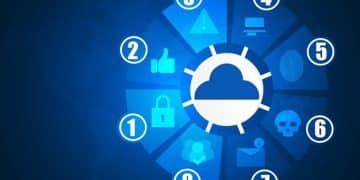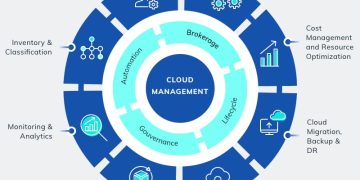Cloud Security Best Practices for US Companies: Jan 2025 Update

Cloud security best practices for US companies in January 2025 encompass strategies like robust access control, data encryption, continuous monitoring, and compliance with evolving regulatory frameworks to safeguard sensitive information in the cloud.
Protecting data in the cloud is a critical concern for businesses operating in the US. This article delves into the cloud security best practices for US companies, updated for January 2025, providing a comprehensive guide to help organizations navigate the complexities of cloud security and safeguard their valuable assets.
Understanding the Evolving Cloud Security Landscape
The cloud security landscape is constantly evolving, with new threats and vulnerabilities emerging regularly. To effectively protect their data, US companies must stay informed about the latest trends and adapt their security strategies accordingly. This includes understanding the shared responsibility model and identifying potential risks specific to their cloud environment.
The Shared Responsibility Model
The shared responsibility model is a fundamental concept in cloud security. It clarifies the division of security responsibilities between the cloud provider and the customer. The provider is typically responsible for the security of the cloud infrastructure itself, including the physical data centers and underlying software. The customer, on the other hand, is responsible for securing their data, applications, and operating systems within the cloud.
Emerging Cloud Security Threats
Several emerging threats are challenging cloud security in 2025. These include increasingly sophisticated phishing attacks, ransomware targeting cloud infrastructure, and supply chain vulnerabilities that can compromise cloud environments. Understanding these threats is crucial for implementing effective security measures.
- Data Breaches: Unauthorized access to sensitive data stored in the cloud.
- Malware Infections: Introduction of malicious software into cloud environments.
- Denial-of-Service (DoS) Attacks: Disruptions to cloud services making them unavailable to users.
- Misconfiguration: Incorrectly configured cloud resources leading to security vulnerabilities.
Adapting to these changes requires continuous learning and proactive adaptation of security strategies. Companies must invest in training, tools, and expertise to stay ahead of evolving threats.
Implementing Strong Access Controls
Controlling access to cloud resources is paramount. Implementing strong access controls limits the potential damage from insider threats or compromised credentials. This involves using multi-factor authentication, following the principle of least privilege, and regularly reviewing user permissions.
Multi-Factor Authentication (MFA)
MFA adds an extra layer of security by requiring users to provide multiple forms of authentication before granting access to cloud resources. This could include something they know (password), something they have (security token), or something they are (biometric scan).
Principle of Least Privilege
The principle of least privilege dictates that users should only be granted the minimum level of access necessary to perform their job duties. This reduces the potential impact of a security breach if a user’s account is compromised.

Strong access controls are a cornerstone of cloud security, preventing unauthorized access and mitigating the impact of potential breaches.
Data Encryption Strategies
Data encryption is essential for protecting sensitive information both in transit and at rest. This involves encrypting data before it’s stored in the cloud and using secure protocols to transmit data between systems. Businesses should also manage encryption keys carefully to prevent unauthorized access.
- Encryption in Transit: Protecting data while it’s being transmitted over networks.
- Encryption at Rest: Securing data while it’s stored on cloud servers.
- Key Management: Securely storing and managing encryption keys.
Strong encryption safeguards data against unauthorized access, even if a breach occurs. Key management is crucial to preventing unauthorized decryption of data.
Continuous Monitoring and Threat Detection
Constant vigilance is key to detecting and responding to security incidents. Continuous monitoring involves tracking system activity, analyzing logs, and using threat intelligence to identify potential threats. Implementing automated alerts and incident response plans help organizations respond quickly and effectively to security breaches.
Security Information and Event Management (SIEM)
SIEM systems collect and analyze security logs from various sources to identify potential threats. These systems can provide real-time alerts and help security teams investigate and respond to incidents.
Threat Intelligence Feeds
Threat intelligence feeds provide up-to-date information about emerging threats and vulnerabilities. Incorporating these feeds into security monitoring systems helps organizations proactively identify and mitigate potential risks.

Continuous monitoring and threat detection provide early warnings of potential security incidents, enabling timely response and minimizing damage.
Compliance and Regulatory Requirements
US companies operating in the cloud must comply with various regulations and industry standards, such as HIPAA for healthcare data, PCI DSS for payment card information, and GDPR for data privacy. Maintaining compliance requires implementing appropriate security controls and regularly auditing cloud environments.
Regular Security Assessments and Audits
Periodic security assessments and audits are crucial for identifying vulnerabilities and ensuring the effectiveness of security controls. These assessments should include penetration testing, vulnerability scanning, and compliance audits. Addressing identified weaknesses promptly helps organizations maintain a strong security posture.
Penetration Testing
Penetration testing involves simulating real-world attacks to identify vulnerabilities in cloud environments. This helps organizations understand their security weaknesses and prioritize remediation efforts.
Vulnerability Scanning
Vulnerability scanning tools automatically identify known vulnerabilities in software and systems. Regularly scanning cloud environments helps organizations stay ahead of potential threats and patch vulnerabilities promptly.
Routine evaluations ensure that security measures are effective and compliant, protecting against emerging threats.
Training and Awareness Programs
Human error is a significant factor in many security breaches. Investing in training and awareness programs helps employees understand their role in cloud security and recognize potential threats. This includes educating users about phishing attacks, password security, and data handling best practices.
- Phishing Awareness Training: Educating employees about identifying and avoiding phishing attacks.
- Password Security Best Practices: Promoting the use of strong, unique passwords and multi-factor authentication.
- Data Handling Policies: Training employees on proper data handling procedures to prevent data leaks.
Security awareness programs empower employees to become a strong line of defense against cyber threats, protecting company data and systems effectively.
| Key Aspect | Brief Description |
|---|---|
| 🛡️ Access Control | Implement strong MFA and least privilege policies. |
| 🔑 Data Encryption | Encrypt data in transit and at rest with robust key management. |
| 🚨 Monitoring | Use SIEM and threat intelligence for real-time threat detection. |
| 📜 Compliance | Adhere to HIPAA, PCI DSS, and GDPR standards rigorously. |
Frequently Asked Questions
▼
The shared responsibility model defines the security responsibilities between the cloud provider and the customer. The provider secures the infrastructure, while the customer secures data and applications.
▼
Multi-factor authentication (MFA) is crucial as it adds an extra layer of security, requiring multiple verification methods, significantly reducing the risk of unauthorized access to cloud resources.
▼
Data encryption safeguards sensitive information both in transit and at rest, ensuring that even if a breach occurs, the data remains unreadable to unauthorized parties, offering robust protection.
▼
Continuous monitoring allows for the real-time detection of threats and anomalies, facilitating a quicker response to potential security incidents and minimizing potential damage and downtime.
▼
Compliance mandates such as HIPAA and PCI DSS necessitate the implementation of specific security controls, ensuring that sensitive data is handled and protected according to regulatory standards, minimizing legal risks.
Conclusion
By implementing these cloud security best practices for US companies, updated for January 2025, organizations can significantly enhance their security posture and protect their valuable data in the cloud. Staying informed, proactive, and vigilant is key to navigating the ever-evolving cloud security landscape.





